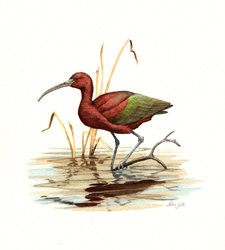Breeding Bird Atlases (BBA)
Find a Bird - BBA1
Breeding Bird Atlas 1 Species Accounts
Glossy Ibis
Plegadis falcinellus
Egg Dates
second week of May to first week of July
Number of Broods
one; may re-lay if first attempt fails.

This small member of the ibis family is thought to be a relatively recent arrival from the Old World. Historically, its center of greatest abundance has been the southeastern coastal states, but the species has a notable habit of wandering great distances and has established nesting records over a wide area of North America. However, its nesting distribution remains erratic, and its status at any given area is often unpredictable from year to year. This pattern seems to hold for Massachusetts as well.
Recorded as an occasional vagrant in Massachusetts as early as 1850, it became regular only after 1947, particularly as a spring visitor, with its periods of occurrence tending gradually to lengthen. It was first discovered nesting in the state at Clark’s Island, Plymouth, in 1974. It occurs generally as a rare and irregular nester at a very limited number of coastal stations (four sites from 1974 to 1979). There were 112 pairs at two known sites in 1977 and 27 pairs at four sites in 1984. To date, there have been two important nesting groups, both associated with Black-crowned Night-Heron and Snowy Egret colonies. The first, at Clark’s Island, increased rapidly to 66 pairs in 1976 but experienced poor reproductive success and slowly declined to zero in 1983-1984. The other important group developed farther north at House Island, Manchester, at about the same time. This colony peaked at 107 pairs in 1977 and was abandoned by 1982.
Spring arrivals appear in early April. Small flocks of migrants may occur inland as well as along the coast into the third week of May, but inland appearances are highly irregular. Colonies are occupied by late April. As is typical of this gregarious species, breeding almost always occurs in association with other waders, usually on islands overgrown with small trees and dense vegetation. On Clark’s Island, nests were located in Arrowwood and Red Cedar. The nests are fashioned from sticks and twigs and are usually 6 to 12 feet above ground. The Glossy Ibis sometimes nests in such great densities with other species of herons that heavy excrement from the colony causes leaf burn and eventual ruination of the habitat. In such instances, the birds abandon the site and move on to other areas.
Save for an occasional series of rasping guttural notes likened to graa graa graa, often vocalized when the birds are disturbed, the Glossy Ibis is very seldom heard away from the immediate vicinity of the nest. At the nest, a more varied repertoire of hoarse grunts and cooing contact calls are exchanged by billing mates or when adults are attending broods.
Nesting behavior is highly ritualized. Both sexes assist with nest building, the male frequently bringing sticks to the nest, where the female seems to perform most of the actual construction. Nests are prepared for eggs in 2 days. Small amounts of nesting material are brought to the nest throughout the nesting period, particularly at nest relief, and are incorporated into the nest platform. The bond between the monogamous pair is strengthened by mutual preening and billing, which are performed frequently, especially at nest relief. Both sexes incubate and tend chicks. The clutch is three to four dull, greenish blue eggs laid on consecutive days, with incubation beginning upon completion of the clutch and lasting for approximately 21 days. Hatching is synchronous.
Young hatch from mid-June to early July and are dependent upon the adults. Chicks feed on regurgitated food, obtained by inserting their bills into the adult’s mouth. Later, food is disgorged into the nest, where it is picked up by the chicks. The young are nestbound for 18 to 21 days, after which they remain in the vicinity of the nest. They are independent at 42 days but may continue to return to the nest at night. By 60 days, the nest site is abandoned, and dispersion occurs, primarily southward. Most pairs at Clark’s Island in 1975 and 1978 reared one chick to at least 10 days of age.
Most Glossy Ibises have left the state by late August. Northern breeders retreat southward to winter along the southern Atlantic coast and in Florida.
Map Legend and Data Summary
Atlas 1 data collected from 1975-1979


Note: very uncommon and local; associated with large coastal heronries, numbers variable
Bradford G. Blodget



